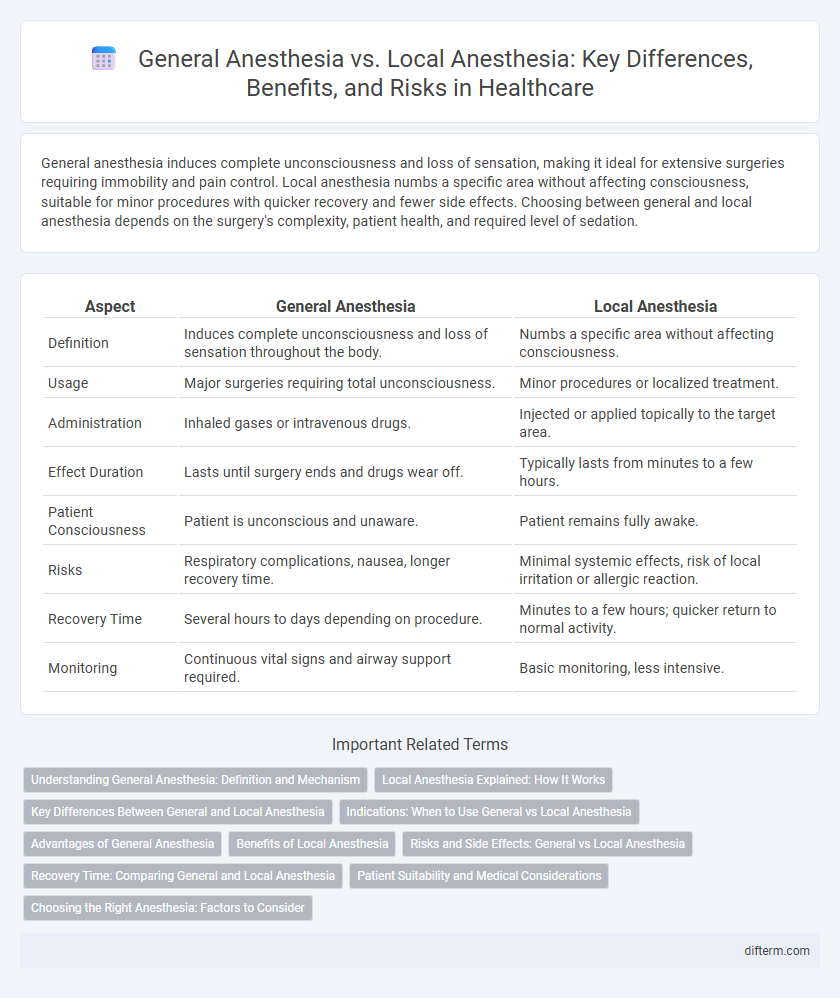General anesthesia induces complete unconsciousness and loss of sensation, making it ideal for extensive surgeries requiring immobility and pain control. Local anesthesia numbs a specific area without affecting consciousness, suitable for minor procedures with quicker recovery and fewer side effects. Choosing between general and local anesthesia depends on the surgery's complexity, patient health, and required level of sedation.
Table of Comparison
| Aspect | General Anesthesia | Local Anesthesia |
|---|---|---|
| Definition | Induces complete unconsciousness and loss of sensation throughout the body. | Numbs a specific area without affecting consciousness. |
| Usage | Major surgeries requiring total unconsciousness. | Minor procedures or localized treatment. |
| Administration | Inhaled gases or intravenous drugs. | Injected or applied topically to the target area. |
| Effect Duration | Lasts until surgery ends and drugs wear off. | Typically lasts from minutes to a few hours. |
| Patient Consciousness | Patient is unconscious and unaware. | Patient remains fully awake. |
| Risks | Respiratory complications, nausea, longer recovery time. | Minimal systemic effects, risk of local irritation or allergic reaction. |
| Recovery Time | Several hours to days depending on procedure. | Minutes to a few hours; quicker return to normal activity. |
| Monitoring | Continuous vital signs and airway support required. | Basic monitoring, less intensive. |
Understanding General Anesthesia: Definition and Mechanism
General anesthesia induces a reversible loss of consciousness and sensation by targeting the central nervous system through intravenous agents or inhaled gases like sevoflurane and propofol. It works by depressing neural activity in the brain and spinal cord, leading to muscle relaxation, loss of pain sensation, and amnesia during surgical procedures. Monitoring vital signs and maintaining airway control are critical components throughout the administration of general anesthesia to ensure patient safety.
Local Anesthesia Explained: How It Works
Local anesthesia numbs a specific area of the body by blocking nerve signals in that region, preventing pain during minor surgical procedures or dental work. It works by inhibiting sodium channels in nerve cell membranes, which stops the transmission of pain signals to the brain. Common local anesthetics include lidocaine and bupivacaine, providing effective pain relief with minimal systemic effects.
Key Differences Between General and Local Anesthesia
General anesthesia induces a reversible state of unconsciousness affecting the entire body and requiring airway management, while local anesthesia numbs a specific area without altering consciousness. General anesthesia carries higher risks such as respiratory depression and requires more monitoring, whereas local anesthesia has fewer systemic effects and is typically safer for minor procedures. Recovery time is longer after general anesthesia due to its systemic impact, whereas local anesthesia allows for quicker postoperative recovery.
Indications: When to Use General vs Local Anesthesia
General anesthesia is indicated for major surgeries requiring complete unconsciousness and muscle relaxation, such as open-heart surgery or abdominal procedures. Local anesthesia is preferred for minor, localized interventions like dental work or skin biopsies where the patient remains awake and pain is confined to a specific area. The choice depends on factors including the procedure's complexity, patient health status, and the need for airway control.
Advantages of General Anesthesia
General anesthesia offers complete unconsciousness and pain relief during complex surgeries, ensuring patient immobility and optimal surgical conditions. It allows for extensive procedures involving internal organs or multiple body parts without patient discomfort or awareness. This type of anesthesia also provides controlled breathing and muscle relaxation, enhancing safety during invasive operations.
Benefits of Local Anesthesia
Local anesthesia offers targeted pain control by numbing specific areas, reducing risks associated with general anesthesia such as respiratory complications and prolonged recovery time. It allows patients to remain conscious and maintain vital functions, promoting faster post-procedure recovery and minimizing hospitalization duration. This type of anesthesia is especially beneficial for minor surgical procedures, outpatient treatments, and dental work, improving overall patient safety and comfort.
Risks and Side Effects: General vs Local Anesthesia
General anesthesia carries risks such as respiratory complications, cardiovascular instability, and postoperative nausea, while local anesthesia primarily poses risks of allergic reactions, localized pain, and temporary numbness. Patients undergoing general anesthesia may experience longer recovery times and potential cognitive effects, whereas local anesthesia typically allows faster recovery and fewer systemic side effects. The choice between general and local anesthesia depends on the surgical procedure, patient health status, and the risk profile associated with each anesthesia type.
Recovery Time: Comparing General and Local Anesthesia
Recovery time after local anesthesia is typically shorter, with patients often regaining full mobility and cognitive function within hours. In contrast, general anesthesia usually requires a longer recovery period, ranging from several hours to a full day, due to its systemic effects and the time needed for the body to metabolize anesthetic agents. Faster recovery with local anesthesia reduces hospital stay and allows quicker return to normal activities, making it preferable for minor procedures.
Patient Suitability and Medical Considerations
General anesthesia is typically suited for patients requiring extensive surgery or those unable to remain still, with considerations including airway management and overall health status like cardiovascular and respiratory function. Local anesthesia is preferred for minor procedures, particularly in patients with high anesthesia risk or multiple comorbidities, as it minimizes systemic effects and recovery time. Patient suitability hinges on medical history, procedure complexity, and potential anesthesia-related complications, guiding anesthesiologists to tailor their approach for optimal safety and effectiveness.
Choosing the Right Anesthesia: Factors to Consider
Choosing the right anesthesia depends on the type, duration, and complexity of the surgical procedure as well as patient health conditions such as age, comorbidities, and allergies. General anesthesia is preferred for extensive surgeries requiring unconsciousness and muscle relaxation, while local anesthesia is suitable for minor procedures targeting specific areas, minimizing systemic impact and recovery time. Patient preference, potential side effects, and postoperative pain management also play crucial roles in determining the optimal anesthesia method.
General anesthesia vs Local anesthesia Infographic

 difterm.com
difterm.com